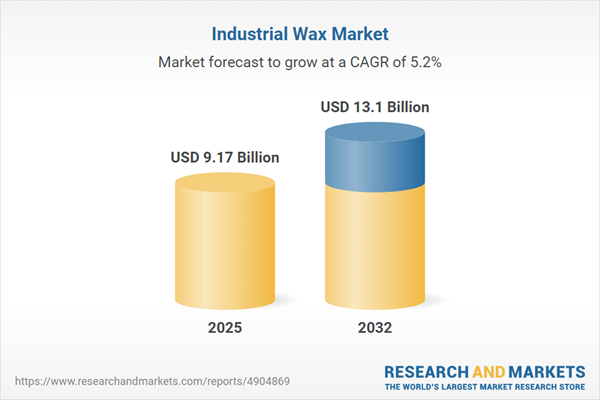Speak directly to the analyst to clarify any post sales queries you may have.
The industrial wax market is transforming as sustainability imperatives, advanced technologies, and shifting regulatory landscapes reshape global production and supply chains. Decision-makers seeking long-term value and operational leadership will benefit from data-driven insights and a comprehensive perspective on where the sector is heading.
Industrial Wax Market Snapshot
The industrial wax market grew from USD 8.74 billion in 2024 to USD 9.17 billion in 2025, and is projected to continue expanding at a CAGR of 5.18%, reaching USD 13.10 billion by 2032. This growth is propelled by rapidly evolving demand patterns across manufacturing, packaging, and high-performance sectors. Strategic alignment with environmental initiatives, rising innovation in formulation, and proactive adaptation to digital technology are influencing how companies capture value and secure supply chain sustainability.
Scope & Segmentation of the Industrial Wax Market
This report delivers a detailed analysis of the industrial wax market, with clear segmentation and regional breakdowns to empower precise decision-making:
- Product Types: Mineral-based waxes: Microcrystalline wax, Paraffin wax; Natural waxes: Beeswax, Candelilla wax, Carnauba wax, Lanolin wax, Palm wax, Rice bran wax, Shellac wax, Soy wax; Synthetic waxes: Alpha olefin wax, Fischer-Tropsch wax, Polyethylene wax (PE wax).
- Forms: Liquid; Powder; Solid (Blocks, Flakes, Pellets).
- Distribution Channels: Offline; Online.
- Applications: Adhesives; Candles (Aromatherapy, Decorative, Household); Coatings & Polishes; Cosmetics & Personal Care (Hair products, Lipsticks, Lotions, Creams); Packaging (Carton sealing, Corrugated boxes, Flexible packaging); Rubber & Tire.
- End User Industries: Art supplies / Education; Automotive; Chemical industry; Construction; Cosmetics industry; Electrical & Electronics; Food & Beverage; Pharmaceutical; Printing & Packaging industry; Textile.
- Geographical Regions: Americas (United States, Canada, Mexico, Brazil, Argentina, Chile, Colombia, Peru); Europe (United Kingdom, Germany, France, Russia, Italy, Spain, Netherlands, Sweden, Poland, Switzerland); Middle East (United Arab Emirates, Saudi Arabia, Qatar, Turkey, Israel); Africa (South Africa, Nigeria, Egypt, Kenya); Asia-Pacific (China, India, Japan, Australia, South Korea, Indonesia, Thailand, Malaysia, Singapore, Taiwan).
- Featured Companies: Akzo Nobel N.V., Calumet, Inc., CALWAX, Clariant AG, Compañía Espanola de Petróleos S.A., DEUREX AG, Exxon Mobil Corporation, Gandhar Oil Refinery (India) Limited, HF Sinclair Corporation, Indian Oil Corporation Ltd, Innospec Leuna GmbH, Kerax Wax, King Honor International Ltd., Koster Keunen, Numaligarh Refinery Limited, Paramelt B.V., RAHA GROUP, Sasol Limited, Shell PLC, The Blayson Group Ltd., The Darent Wax Company Limited, The International Group, Inc., Waxoils Private Limited, Alexandria Mineral Oils Company.
Key Takeaways for Senior Decision-Makers
- Industrial waxes are integral to applications spanning electronics, packaging, and personal care, with increasing reliance on material innovation for performance and sustainability.
- Evolving regulations and global demand drivers are accelerating adoption of bio-based and synthetic waxes, prompting industry shifts towards alternative feedstocks and greater traceability.
- Technological advancements, including digital supply chain monitoring and additive manufacturing, are optimizing production, distribution, and waste reduction.
- Regional dynamics highlight Asia Pacific as a hub of consumption and innovation, while Europe emphasizes environmental stewardship and North America invests in domestic capacities.
- Strategic alliances, mergers and acquisitions, and collaborative product development are shaping competitive positioning and resilience to supply chain fluctuations.
Tariff Impact: Navigating U.S. Trade Policy Changes
New U.S. tariff measures implemented in 2025 are driving a reassessment of sourcing and supplier portfolios, impacting the cost landscape and procurement strategies for importers and domestic producers. Supply chain agility and scenario planning are crucial as market participants seek to mitigate margin pressures and ensure continuity amid region-specific regulatory shifts.
Methodology & Data Sources
Primary research featured direct interviews with executives across the value chain, complemented by extensive secondary reviews of industry publications, patent records, and trade statistics. Insights were triangulated through structured validation sessions and cross-referenced with government and association data to ensure both quantitative rigor and real-world relevance.
Why This Report Matters: Strategic Value for Industrial Wax Leaders
- Enables informed investment, procurement, and partnership decisions by presenting actionable segmentation and regional intelligence.
- Equips leaders with deep understanding of regulatory, technological, and competitive forces driving industrial wax market transformation.
- Supports scenario planning and long-term strategy development amid regulatory, technological, and supply-chain uncertainty.
Conclusion
This report provides a comprehensive, data-driven analysis of the industrial wax market, equipping stakeholders with the insights needed to drive sustainable growth and operational excellence. Strategic adaptation and collaborative innovation will empower market participants to capture opportunities in an evolving global landscape.
Additional Product Information:
- Purchase of this report includes 1 year online access with quarterly updates.
- This report can be updated on request. Please contact our Customer Experience team using the Ask a Question widget on our website.
Table of Contents
3. Executive Summary
4. Market Overview
7. Cumulative Impact of Artificial Intelligence 2025
Companies Mentioned
The companies profiled in this Industrial Wax market report include:- Akzo Nobel N.V.
- Calumet, Inc.
- CALWAX
- Clariant AG
- Compañía Espanola de Petróleos S.A.
- DEUREX AG
- Exxon Mobil Corporation
- Gandhar Oil Refinery (India) Limited
- HF Sinclair Corporation
- Indian Oil Corporation Ltd
- Innospec Leuna GmbH
- Kerax Wax
- King Honor International Ltd.
- Koster Keunen
- Numaligarh Refinery Limited
- Paramelt B.V.
- RAHA GROUP
- Sasol Limited
- Shell PLC
- The Blayson Group Ltd.
- The Darent Wax Company Limited
- The International Group, Inc.
- Waxoils Private Limited
- Alexandria Mineral Oils Company
Table Information
| Report Attribute | Details |
|---|---|
| No. of Pages | 187 |
| Published | November 2025 |
| Forecast Period | 2025 - 2032 |
| Estimated Market Value ( USD | $ 9.17 Billion |
| Forecasted Market Value ( USD | $ 13.1 Billion |
| Compound Annual Growth Rate | 5.1% |
| Regions Covered | Global |
| No. of Companies Mentioned | 25 |









